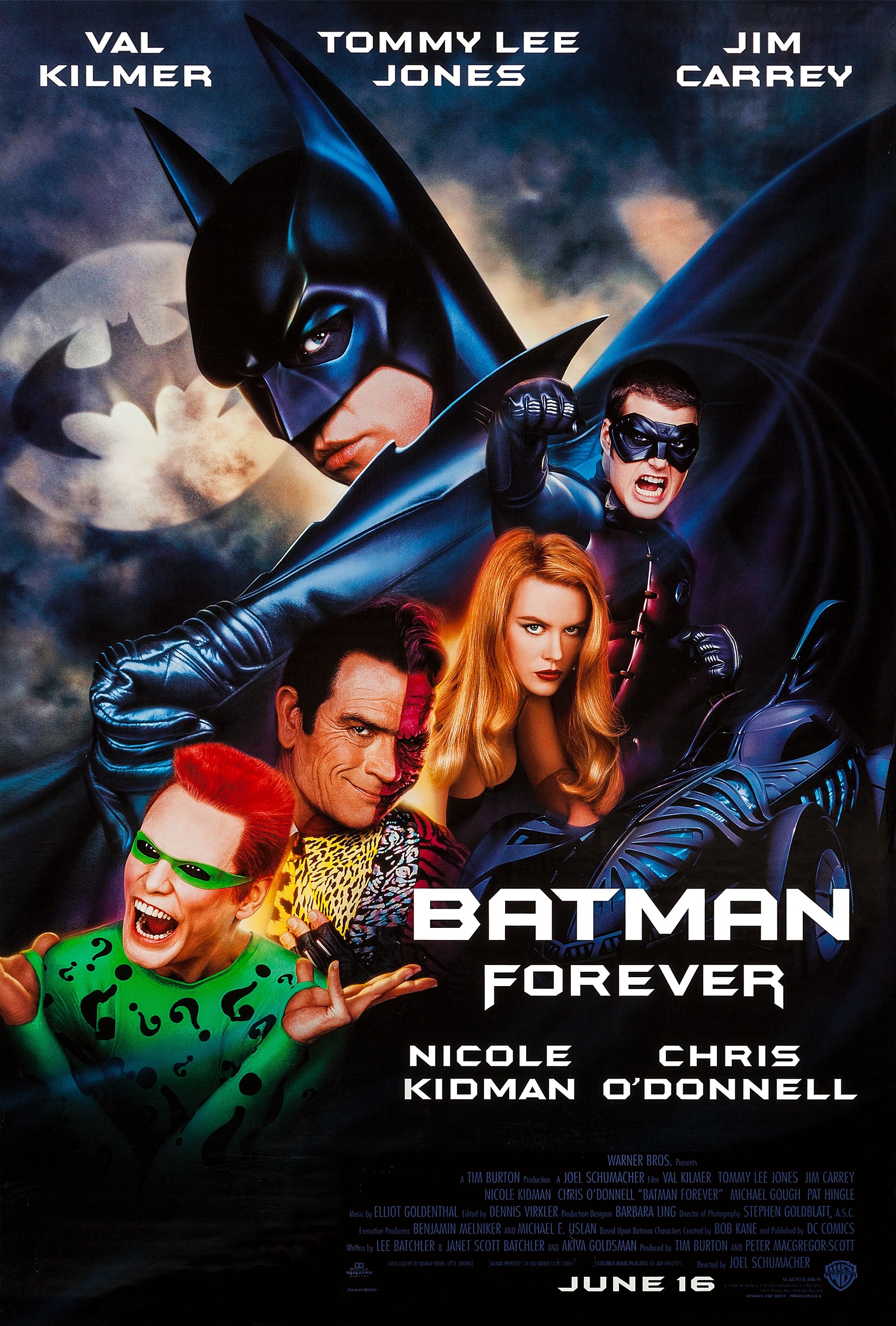By Christian Eltell
Written and Published on July 6, 2020
Critic Rating: 3.5/4 Stars
25th Anniversary Review

The Riddler: “Please, you’re as blind as a bat!”
Batman: “Exactly!”
25 years ago, the late great Joel Schumacher took over the direction of Batman after Tim Burton’s brilliant work (Batman and Batman Returns). While Schumacher’s two Batman films were not as well-received compared to Burton’s, nor Christopher Nolan’s Dark Knight trilogy years later, Schumacher’s Bat films were funny and entertaining to view. Batman and Robin did go a bit overboard, but Batman Forever was decently made in terms of combining the light and dark elements of the character.

Batman Forever involves the Dark Knight taking on two villains. One of them is Harvey “Two-Face” Dent, former Gotham District Attorney turned killer criminal who blames the Bat for getting half his face messed up. The other is Edward Nygma, a Wayne Enterprises employee whose innovative but dangerously questionable experiment on analyzing people’s brain waves is rejected by billionaire Bruce Wayne. Nygma ingeniously becomes The Riddler (with nice question marks on his elaborate costumes) in order to take down Wayne (getting his attention with “wacko” and clownish riddles), and to help Two-Face discover the true identity of Batman in return for stolen riches to build his empire and help him read every person’s mind in Gotham.
While Batman has two enemies to fight against in Gotham City, his alter-ego, Bruce Wayne, has personal demons of his own. He has terrifying memories of his parents’ deaths when he was a young child, and recalls seeing a bat that would symbolize the hero he grows up to become.
What makes Val Kilmer’s Batman and Bruce Wayne likable is his conflict with dual identity, and whether or not he can be two people at once. Michael Keaton’s Bruce Wayne/Batman in Burton’s films also briefly contemplated with this issue very convincingly. However, while Keaton’s protagonist was more to himself and boxed in (although rightfully so in order to be mysterious), Kilmer’s role feels a little more open on this struggle, especially during his scenes, as Wayne, with Dr. Chase Meridian (portrayed with intelligence and beauty by the wonderful Nicole Kidman). Wayne’s bonding relationship with Meridian, as well as their therapeutic and intimate confrontations, is one of the best elements of the film. Batman/Bruce and Chase have a sparkling chemistry that was somewhat lacking in Burton’s first Bat film in the relationship between Keaton’s Batman/Bruce and Kim Basinger’s Vicky Vale.
Wayne also has Dick Grayson, an acrobat who loses his brother and parents to Two-Face. When Dick stays with Wayne in his manor and discovers his secret identity as Batman, Dick wants his assistance in getting revenge, but Bruce fears that making Dick his partner in crime would only get him killed. Dick’s alter-ego, Robin, is introduced, as he desperately tries to get Batman/Wayne to help him take down Two-Face.
As Bruce tells Chase, “we are all two people,” and it’s this contemplation of dual identity, and the idea that every person has two sides, that is at the heart of this Batman film. Bruce Wayne has to come to terms with whether or not he can live a life both as a billionaire and as a superhero. Does Chase love Bruce or Batman? Can Dick seek vengeance and/or justice for his family as Robin, or will he keep running away on a lonely path? Harvey “Two-Face” Dent was once a man of law and order, until he turned into a thief and cold-blooded murderer, and has a special two-sided coin that helps him decide who lives and dies by his hands. Edward Nygma was content with his life as a Wayne Enterprises inventor, but then he wanted more, more control, more power, and the ability to make his own decisions and deceive others by reading minds and encountering everyone’s most pivotal secrets.
Joel Schumacher’s Batman Forever is cool, stylish, action-packed, funny, entertaining, and enjoyable to watch. While Tim Burton’s Batman films were a little more darker and blended with film noir, Schumacher does similar work but is able to make Batman/Bruce Wayne more open toward his personal feelings, and questioning his dual identity. There is some over the top dialogue (from minor characters such as Gotham reporters and a police officer held captive in the beginning), and colorful setups (brightly lit-up buildings) that could have been toned down a little, but do provide an elaborate atmosphere for Gotham City. Tommy Lee Jones (generally known for his dramatic roles) is able to portray a role in Two-Face that requires him to be a crazy, twisted, and comical villain. Jim Carrey is always hilarious, and was born to play The Riddler due to his maniacal madness and undeniable ability to make us laugh in every situation. Chris O’Donnell’s Robin, while a bit cocky, is tough, youthful, and ambitious. Nicole Kidman portrays Dr. Chase Meridian as a beautiful female protagonist who cannot decide if she loves the superhero or billionaire more, but is fascinated and attracted by both. She likes Batman’s ability to fight evil in a way others can’t, and she wants to help Bruce fight past the awful memory of his parents’ murder. Val Kilmer is a suave, calm, and resourceful Bruce Wayne, as well as a tough and persistent crime fighter in Batman. And in both cases, you can also sense the anguish he feels for the parents he lost, especially when he tells Chase about his parents’ funeral when he was a child, running in the rain with his father’s journal, and falling down a whole, before looking at a bat going toward him. His empathy for Robin also displays Bruce’s understanding towards family loss. Michael Gough’s Alfred, as in Burton’s films, is not only a reliable butler, but also a caring friend and father figure towards Bruce and Dick. Pat Hingle’s Alfred, although a minor character in Burton’s and Schumacher’s Bat films, is a likable Commissioner Gordon.
The action sequences, such as the opening chopper scene, Batman infiltrating the Nygmatech party and fighting Two-Face’s crew, and Batman facing Two-Face and Riddler at Nygma’s fortress in the end, are well staged. While Danny Elfman’s score was memorable and complimentary with the gothic visuals in Burton’s films, Elliot Goldenthal’s score is also great in Schumacher’s pictures because it manages to be playful during the comical parts, as well as suspenseful and exciting during the fights/confrontations between heroes and villains. Seal’s Kiss From A Rose also became a memorable and household song for many. I still can’t believe this song wasn’t popular before this film, but thanks to Seal for a classic song, and thanks to Joel for recognizing it and placing it in the end credits for the film’s soundtrack, along with a nice music video. The song perfectly fits with the film’s themes on love, lightness and darkness, and the symbolism of a rose, which for the film represents the love and memories Bruce had for his parents, as well as for Chase.
While Nolan and Burton’s Batman films are great, so is Joel Schumacher’s Batman Forever. This film, and Val Kilmer’s portrayal, was my favorite of the first four films before Nolan’s trilogy. The film could have been more complex, and a little darker in tone, but the cast, the action, the plot, the concept of dual identity, and the combination of a partly dark/tormented Batman with light/comical villains made Batman Forever a great superhero/Batman film in my book. Thank you Joel and everyone apart of it. This brought back childhood memories of my own.
